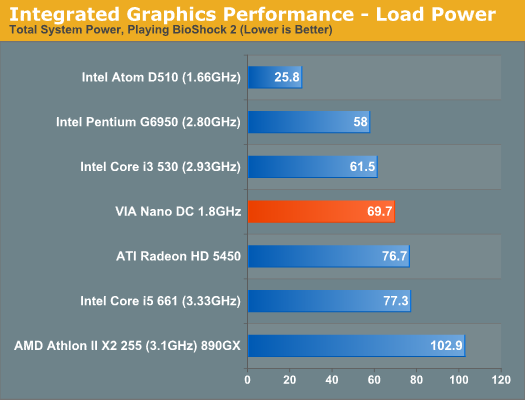VIA's Dual Core Nano & VN1000 Chipset Previewed
by Anand Lal Shimpi on November 15, 2010 12:26 PM ESTPower Consumption
The DC Nano platform I tested is built on an old 65nm manufacturing process at TSMC. As a result, power consumption isn't that great. Also note that VIA doesn't do any power gating, so idle power ends up being very similar to Clarkdale:


While the DC Nano platform may have the performance advantage, it requires at least twice the power of Intel's Pine Trail Atom platform. The move to 40nm will definitely help things, but I doubt we'll see Atom levels of power consumption from the final DC Nano platform.










54 Comments
View All Comments
Marlin1975 - Monday, November 15, 2010 - link
Why 65nm? Does TSMC only allow larger companies their 40nm?Why this, as you pointed out, over bobcat?
Yea VIA is still around but they will not be for long if they keep playing softbal like this. They need to take a big chance like AMD did with the orignal Athlon. Either come to win or be swept up by the bigger fish.
Mr Perfect - Monday, November 15, 2010 - link
The article says they're releasing 40nm in 2011, so this is probably just to tide them over.wazzap123 - Friday, November 19, 2010 - link
Yeah, there's a good analysis over at the daily circuit.http://www.dailycircuitry.com/2010/11/nano-duo.htm...
nafhan - Monday, November 15, 2010 - link
I think TSMC is pretty constrained on their 40nm node right now. Also, VIA probably had the design ready to go for 65nm.I agree with your "why would anyone buy this" sentiment, though. Bobcat seems to be aimed at almost the same market segment. Even though this seemed to work fine, between VIA and AMD, I'll trust AMD to deliver good drivers 10 times out of 10.
softdrinkviking - Tuesday, November 16, 2010 - link
If nano turns out to be less expensive than bobcat, I can totally see it's relevance.I'll never play a big game like MW2 on a small mobile platform anyway, so if nano and bobcat both load web pages and allow me to type documents at about the same speed, I'll buy the cheaper one.
FATCamaro - Monday, November 15, 2010 - link
From the days of the KT266 onwards they have been worthless. More power at idle and load than an i3 530. Good job!!!GeorgeH - Monday, November 15, 2010 - link
This is a pre-production 65nm sample VIA is using to give performance previews. The actual shipping product will be 40nm and have lower power consumptiion.Also, VIA made some good enough chipsets post KT266. Bang for your buck was often hard to beat - such as when VIA was one of the only ways to get a P4 with DDR SDRAM.
Goty - Monday, November 15, 2010 - link
I loved my old MSI KT3-Ultra motherboard running Via's KT333 chipset. I think it's still doing duty somewhere for my parents.juampavalverde - Monday, November 15, 2010 - link
Yupp! That MSI was a hell of a good board, i friend had one and sold it to another friend, its still alive and kicking with an overclocked throughbred.I had an Asrock KT600 board, the thing was the cheapest cr@pp around with sata those days, always was solid, with reasonable performance. Also still working (not at my home) with a barton, a couple of ddr gigs, and a radeon 9600, pushing win7 x86 nicely.
VIA didnt have a consistent platform for 478/775, but at amd chipsets (462,754,939) they did well in the agp times.
yuhong - Tuesday, November 16, 2010 - link
And I remember reading nForce4 being troublesome in the PCIe times. Did VIA gain from it?